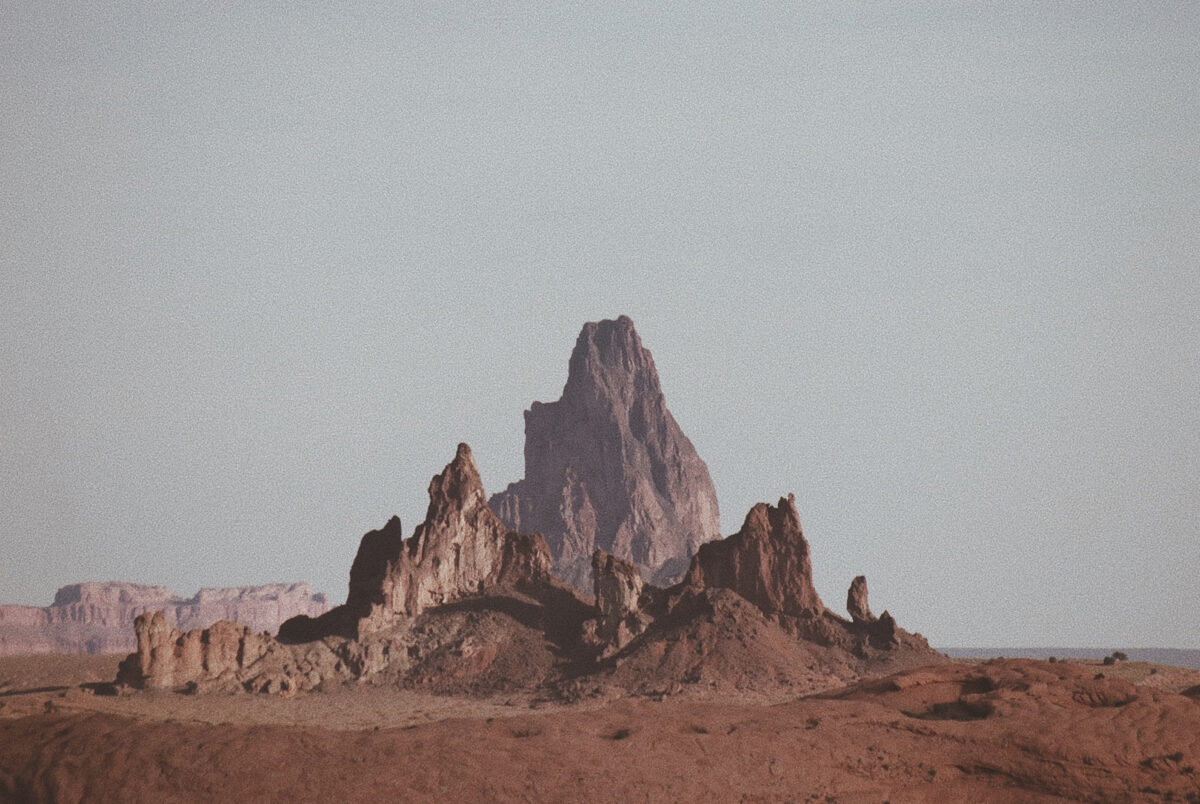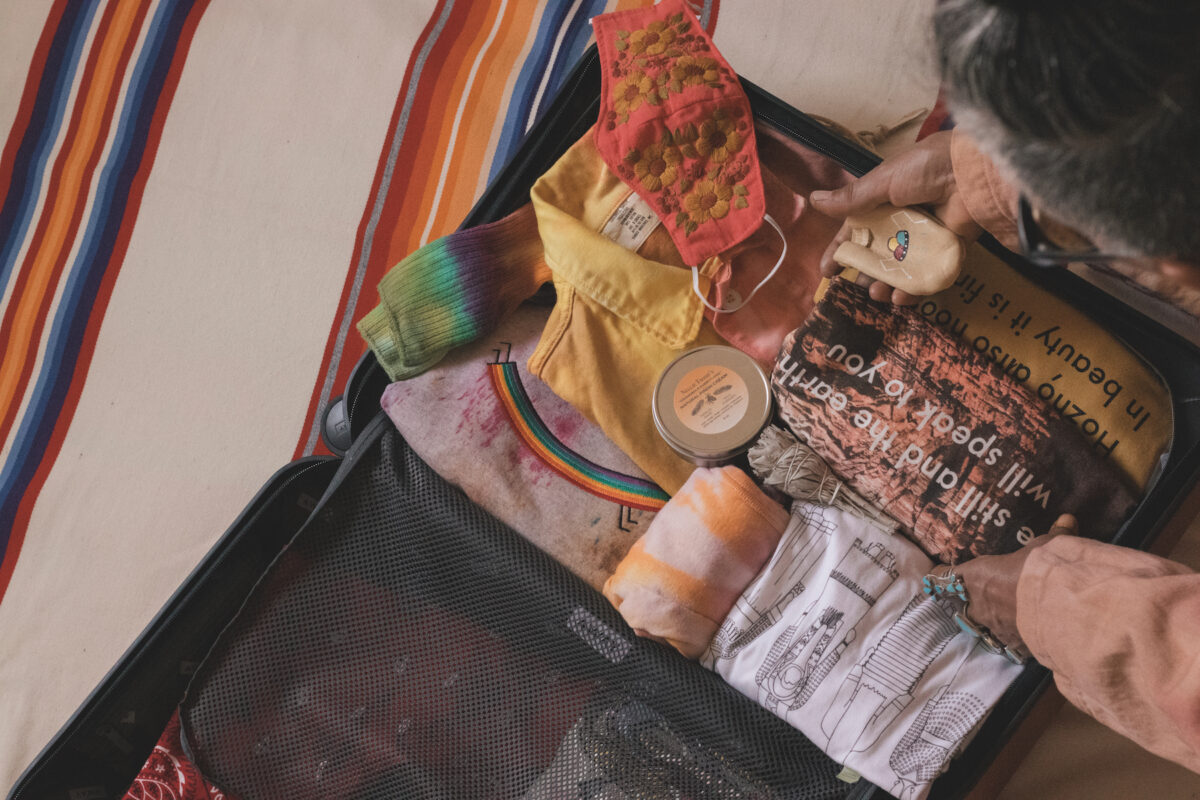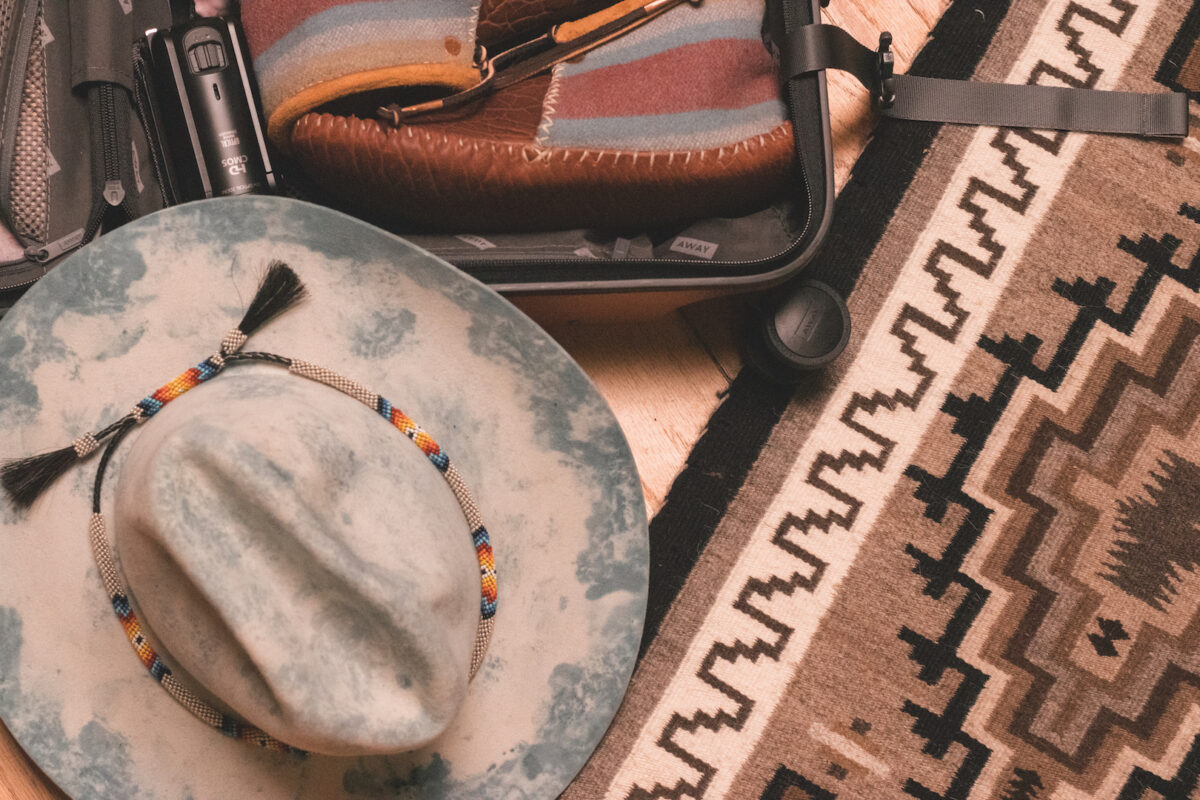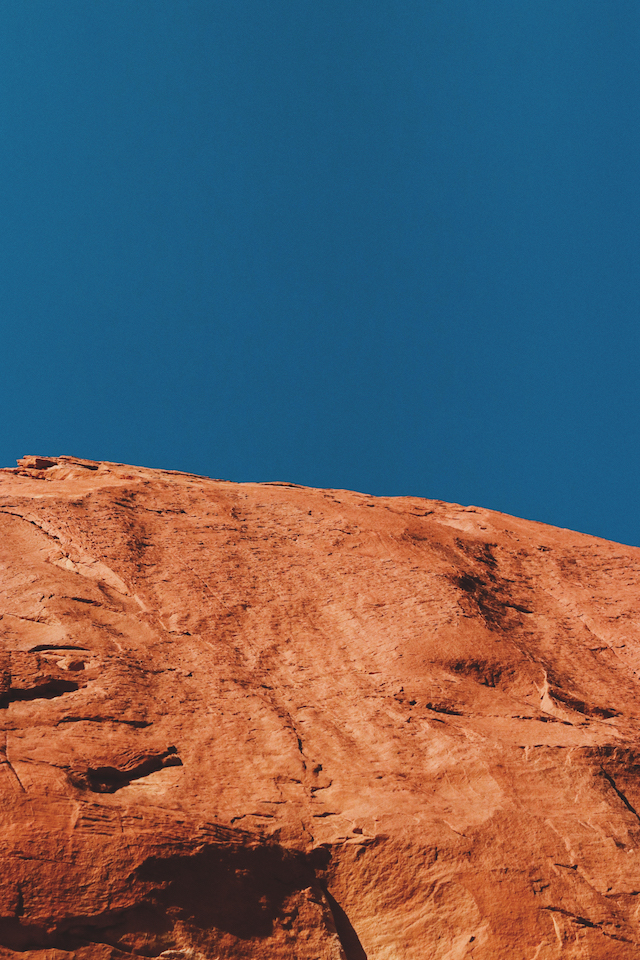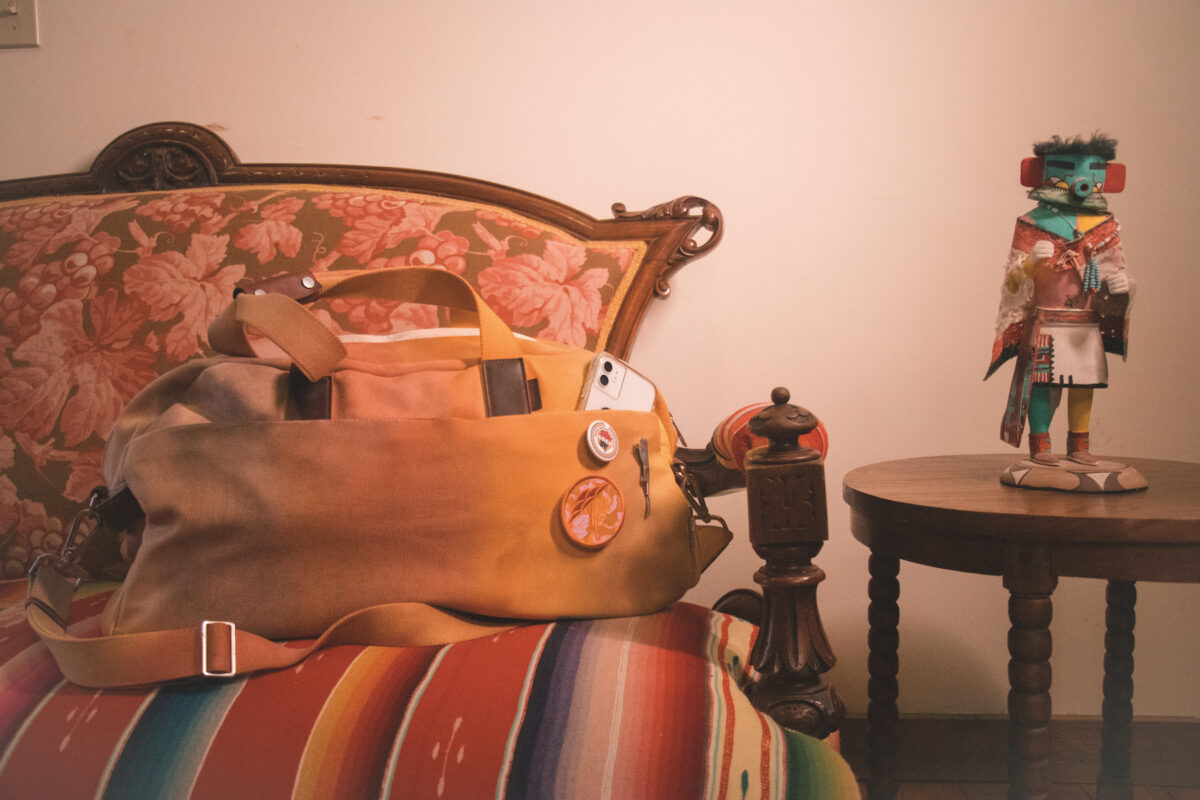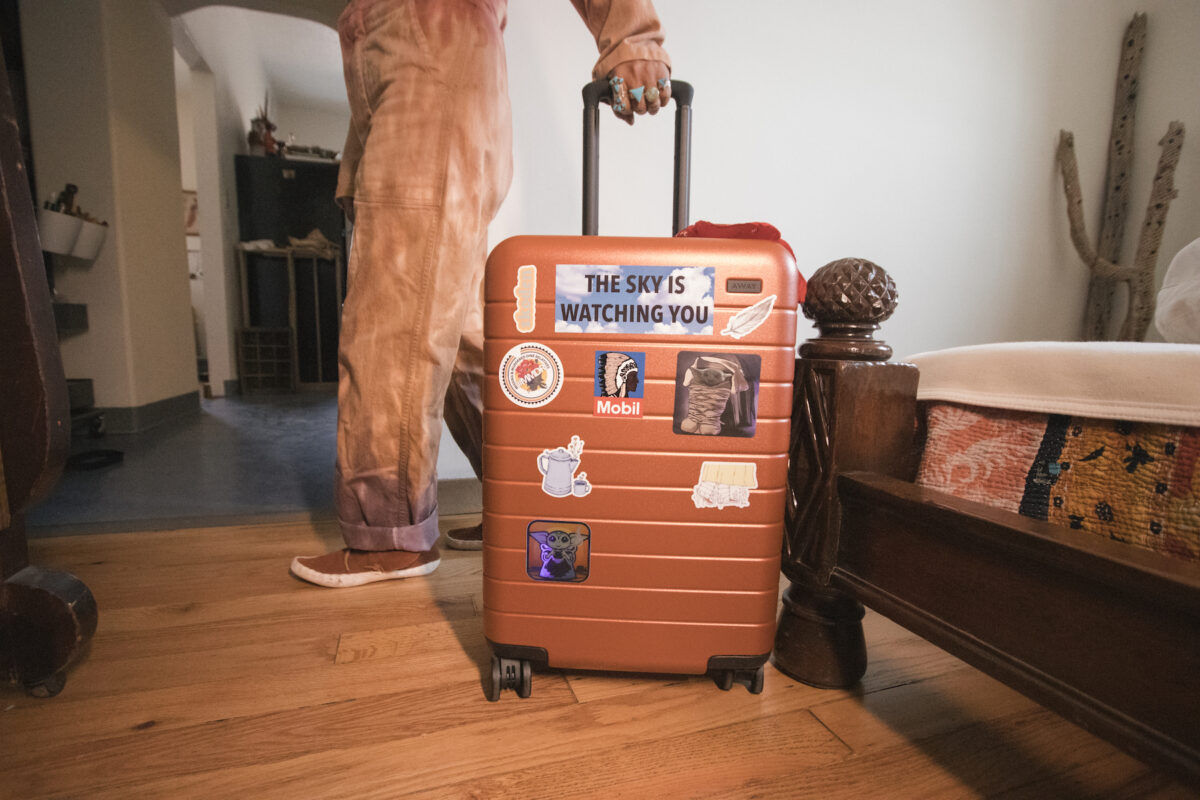Whether challenged to reconnect to the land or reconnect to her roots, Amy Yeung always rises to the occasion. Here, the founder of eco-conscious brand Orenda Tribe talks family, finding herself, and the future of fashion—plus, she shares what she carries with her when she’s not home in Navajo Nation.
Amy Yeung lives in swathes of rainbow tie-dye complemented by a crown of shining silver hair—and this is just one of many reasons why I want to be just like the owner of upcycled vintage brand Orenda Tribe when I grow up.
Yeung also refuses to linger on the negative. She gives back to her people, almost relentlessly. She’s the first to admit, even after all this time, that she’s still learning. And—perhaps my favorite thing about her—she isn’t afraid to keep it real.
“My generation fucked everything up,” Yeung says. (You love to see it.) “I’m a boomer, so I’m still trying to fix what I broke. But for [my daughter], it’s all about really taking care of this planet.”
“For [my daughter], it’s all about really taking care of this planet.”
Just days before we catch up, Yeung’s daughter and best friend, Lily, moved back to the Southwest from Los Angeles to spend some quality time with her family in New Mexico’s wide-open spaces.
Yeung went on a similar journey herself not so long ago. Once upon a time she, too, lived in L.A., where she spent 30 years designing for fast fashion and corporate brands. But in the latter days of her career, her priorities began to shift: To set a better example for her daughter, Yeung prepared to change in all aspects of her life.
First, in 2015, she bid adieu to Big Fashion and launched Orenda Tribe, a fashion line with a focus on—and strong passion for—sustainable practices. Rather than contributing further to fast fashion’s waste, Yeung and her team breathe new life into old clothes, upcycling vintage textiles and garments into one-of-a-kind pieces.
Then, just a few years later, Yeung took another step she hoped Lily would follow: In 2019, she said goodbye to her longtime home in California, packed up only what was necessary to run Orenda Tribe, and moved to the Southwest to embrace her roots as a Diné woman.
California’s history through the lens of the Native Nations →
Now, wearing her signature thick-framed glasses (vintage Dries Van Noten by Linda Farrow—I’d been dying to know), Yeung greets me over video from her current home: a bright, colorful space on the Navajo Nation territory in New Mexico.
It was around her one-year mark in New Mexico that COVID-19 arrived in the U.S. and left Indigenous communities—who are disproportionately affected by the current public health crisis as a result of exclusion from national coronavirus data and limited access to testing and adequate health services—reeling in its wake.
What Yeung quickly points out, however, is that the novel coronavirus didn’t create novel problems; instead, the pandemic shone a light on many of the issues Diné people have long faced.
“I’d much rather hang out with my sisters and my matriarchs.”
“Everybody who’s Navajo [knows] none of this is new to us,” Yeung says. “One-third of our population is without water and electricity. If you’re from the Navajo Nation, that’s how it’s been. And the pre-existing health conditions that caused the accelerated effect we had with COVID-19, that’s also nothing new.”
But Yeung and her community aren’t ones to wait around for the powers that be to intervene.
“I’d much rather hang out with my sisters and my matriarchs, get together, and just get shit done,” she says. “That’s how things are going to change. That’s how we’re gonna get through this.”
How COVID-19 impacted the travel industry worldwide →
Together, they’ve done just that. Yeung’s experience in fast fashion—which hinges on rapid timelines, ample fundraising, and constant change—helped her move quickly, and devising creative solutions for the community’s problems came naturally. In the time since the pandemic swept Navajo Nation, Orenda Tribe has teamed up with other Diné-run initiatives like Protect the Sacred, Sixth World Solutions, and UnitedNatives.org to deliver medical PPE to locals, firewood and supplies to elders, and meals to thousands of children across the Reservation.
And in supporting the earth and the Navajo community, Yeung naturally and enthusiastically supports another group: the next generation. Through Orenda Tribe, she isn’t only on a mission to set an example for her daughter, but for all Diné youth.
“As an older matriarch, I want to elevate our future generation of creatives.“
“As an older matriarch, I want to elevate our future generation of creatives and lift them up, because they’re what’s going to happen after me,” Yeung says. “That’s why a lot of them have space in my shop and we just sell [their wares] for a hundred percent back to that artist—I want to be a good relative for them. I’ve had that time in my career. It’s time to raise them up.”
Yeung’s story and life’s work is a lesson in tradition. There are some traditions worth breaking: the perpetual cycle of fast fashion, humanity’s tendency to exploit the earth, the apathy we harbor for our fellow man. And others worth holding on to: those that bring us closer to the people we love, to the heritage that defines us, and to the planet we call home. Here, Yeung shares the things that she’s bringing with her from the past into what she believes is a bright future ahead.
Q: What do you envision for the future of fashion?
A: We wouldn’t be seeing retail crumbling right now if people were really digging that [mass-produced] vibe. This pandemic came because Mother Earth is just saying wake up, wake up!—and that includes everybody in fashion. We need to do things that are valuable. We need to do things that last a long time. We need to do things that have love and intention put into them, not just random, cheap shit that we’re gonna throw away. Those days are done.
Q: What does eco-friendly fashion look like to you?
A: [Sustainability] almost always comes from small-batch designers, because we don’t need to be these giant producers of stuff. We do much better when we’re small businesses. Then, you get this beautiful selection of things that are authentic to the artists creating them. That gets lost sometimes when brands get really massive and you lose that originality and passion you started with. So I always seek smaller brands or things made in small batches because it’s done with intention and love. When something’s handwoven, when something’s hand-beaded, it’s just this feeling you have and you connect with it. Or if it’s a really beautiful old piece, there’s a certain energy to old vintage items because they’ve already lived with someone and you’re bringing that energy into your life as well.
In Rome, vintage shopping offers respite from fast fashion’s waste →
Q: How does life in New Mexico influence your current work?
A: Certainly with the pandemic, color therapy has been a really important part of processing all these feelings of being scared and not knowing. I just go out and tie-dye every day, and of course, I’m doing rainbows and sunsets—that’s the shit that makes me happy, that makes me feel good. I am hopeful because Father Sky—here in New Mexico right now, it’s all blue skies and white clouds—speaks to you if you become quiet enough to become one with where you are. So I’m not really doing it—it’s like I’m a conduit for the sky to speak through.
Q: What are your personal favorite garments from Orenda Tribe?
A: What I like right now are things that bring me comfort and joy—and that’s definitely our rainbow sweat suits and summer sets, because they’re like grown-up Garanimals onesies. I feel like I’m a baby, but I’ve grown up in my all-in-one colored suit. I just run around and I’m super happy all the time.
How to spend a weekend in Taos, New Mexico →
Q: What lessons from the Rez do you carry with you on the road?
A: Being conscious, being empathetic, helping those that are more vulnerable than you; not having such a focus on wealth and ego, but to have a sense of community and service. These are the Diné lifeways; this is how we move through life. Even now, the healing pathway for me is through k’é, a Diné word that means “kinship.” It means that through communities, through being this way together, we can heal going forward.
We’re all really restricted right now, and we’re traveling more within where we live. Maybe we didn’t do that so much before, but now, more than ever, is the time for us to connect with other people from our state or city and really get to know them and take the time to talk. We were all so busy flying around and doing stuff before. Now is the time that you really do embrace your humanity, and part of that is still keeping that passion for adventure and travel—but it’s gonna be on a community level now.
Q: When you’re traveling away from the Rez, what’s the one thing you always bring along?
A: Oh my gosh, I never travel anywhere without Nellie Tsosie’s piñon salve. It’s made from piñon sap, which is from a tree on the Rez. The porcupine comes and scratches the tree and then the sap comes out, and you harvest the resin in the sap. That’s the protection for the tree from outside diseases, so for us, we can use it on our bodies for everything: for eczema, for a cut, for a blister, for a mosquito bite, for a sunburn, for your lips. Plus, you smell really great because of the sap!
A version of this story appeared in Here Magazine issue 14.
- 1(Hand-Dyed!) Away Weekender Bag, $245
- 2Away Bigger Carry-On in Sand, $245
- 3Orenda Tribe hand-dyed chonies, $35
- 4Orenda Tribe upcycled flysuits, $395
- 5Orenda Tribe hand-dyed sweat suit, $195
- 6B.Yellowtail Trade Cloth Chukka Moccasins, $400
- 7Xiomara embroidered masks by Folk Project, $15
- 8Orenda Tribe upcycled Cloudwalk hat, $395
- 9Protective ghost beads, $30
- 10Nellie Tsosie’s piñon cream and Navajo healing ointment, $35
- 11Shy Natives bralettes (coming soon!)
- 12Cheekbone Beauty Kéyah lipstick (Sustain Lipstick collection) in Nude, $32
- 13B.Yellowtail Good Medicine Tee, $38
- 14B.Yellowtail Protect Her Tee, $42
- 15B.Yellowtail Bison Star lotion travel duo, $16


